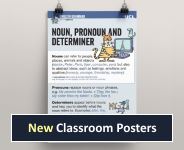Glossary
The Englicious Glossary includes the new National Curriculum glossary terms, which are shown against a white background. However, there's much more to be found here:
- we have added many entries that we feel are important, but cannot be found in the NC Glossary (e.g. connective), and
- in many cases we have added information to the (often very brief) NC entries that need further explanation (e.g. clause and phrase).
Please note that in line with our practice throughout the site, we use capital letters for function terms such as Subject, Direct Object, Indirect Object, Modifier, etc. Although this convention is not followed in the documentation published by the Department for Education we have also done so in the text that forms part of the National Curriculum Glossary.
Tip: Within our units and resources, Glossary items appear highlighted within the text. When you hover over them, or click on them in the Slideshow, a popup is generated.
gender
genre
GPC
gradability
gradience
For example, let’s look at the fuzziness or gradience of the noun category. Cat, table and apple are all deemed to be ‘prototypical’ members of this category. They are physical objects; they take a possessive form; they can be plural or singular, and they can appear after a determiner.
But news and information are more peripheral examples of nouns. The former is always in the plural, and the latter cannot take a plural ending.
grammar
grammatical
grammatical form
grammatical function
grammatical word
grapheme
A letter, or combination of letters, that corresponds to a single phoneme within a word.
- The grapheme t in the words ten, bet and ate corresponds to the phoneme /t/.
- The grapheme ph in the word dolphin corresponds to the phoneme /f/.
grapheme-phoneme correspondence
The links between letters, or combinations of letters (graphemes) and the speech sounds (phonemes) that they represent.
In the English writing system, graphemes may correspond to different phonemes in different words.
- The grapheme s corresponds to the phoneme /s/ in the word see, but…
- …it corresponds to the phoneme /z/ in the word easy.
Grice's maxims
1 quantity: make your contribution as informative as is required for the current purposes of the exchange - don't say too much or too little
2 quality: try to make your contribution one that is true
3 relation: be relevant
4 manner: be perspicuous - avoid unneccessary obscurity and ambiguity

